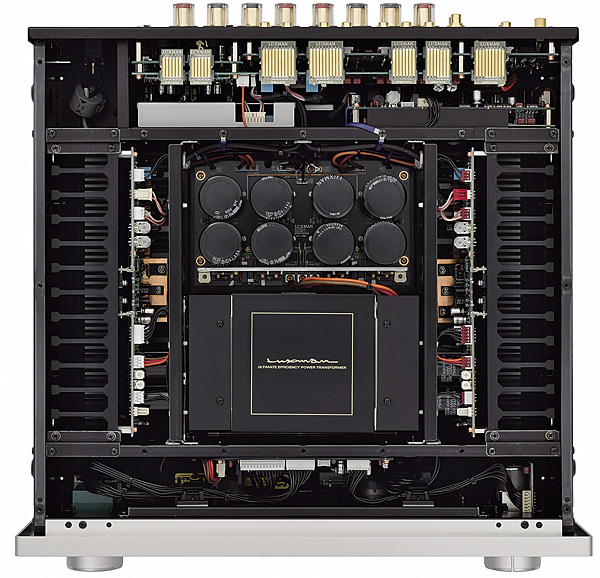Luxman L-509X integrated amplifier Page 2
![]() Sweet And Easy
Sweet And Easy
Not that there’s anything brutal about the way this amplifier plays music. Give it a while to settle down from cold – as PM noted during his lab testing, when set to play at a given output level the meters kick up a bit after a while of running, at which point the L-509X can be assumed to be cooking pretty well, and good to go. And the immediate impression is that, while there’s no mistaking this for an amplifier with anything less than ‘more than sufficient’ power under the hood, it sounds sweet, refined and entirely at ease, whatever the music you choose to play through it, and whichever source component you opt to use.
 It’s not quite a ‘take no prisoners’ ultra-revealing amp of the brash and bright school, though the amount of information it delivers is frequently breathtaking, and it never leaves the listener with the sense that something’s missing. So however big and rich the bass may be it’s also entirely controlled, tight and rhythmic as well as having wonderful character. From the growl of orchestral double-basses in a spot of Wagner from the excellent overview of the composer’s work by Iván Fischer and his Budapest Festival Orchestra [Channel Classics CCS SA 32713; DSD64], all the way through to the snap and punch of Kyle Eastwood’s instruments on his recent In Transit set [Jazz Village JV570146; 44.1kHz/24-bit download], this is an amplifier fully able to convey instrumental textures and techniques.
It’s not quite a ‘take no prisoners’ ultra-revealing amp of the brash and bright school, though the amount of information it delivers is frequently breathtaking, and it never leaves the listener with the sense that something’s missing. So however big and rich the bass may be it’s also entirely controlled, tight and rhythmic as well as having wonderful character. From the growl of orchestral double-basses in a spot of Wagner from the excellent overview of the composer’s work by Iván Fischer and his Budapest Festival Orchestra [Channel Classics CCS SA 32713; DSD64], all the way through to the snap and punch of Kyle Eastwood’s instruments on his recent In Transit set [Jazz Village JV570146; 44.1kHz/24-bit download], this is an amplifier fully able to convey instrumental textures and techniques.
What’s more, while the brass duo leading several of the Eastwood tracks can sound overly aggressive via some amps, the L-509X conveys them in fluid, attractive fashion without blunting either their breathiness or the metallic edge to the sound. In other words, it does excitement to spellbinding effect – just without the irritation. Even with a really dense mix, such as some of those on Squeeze’s The Knowledge [Love Records LVRCD004], this amplifier manages the impressive task of delivering the big, majestic wash of sound while still allowing the usual masterful lyrics and the individual instruments due clarity.
No Excuses Needed
The L-509X rewards both ‘lean back’ and ‘lean forward’ listening, not least because it always seems entirely in control of the speakers, with no sense of speed-impeding smear or overhang. Notes start sharply and decay realistically, giving a sound that’s both immediate and delivered with real presence. It’s a sound that even the wilful mayhem of the latest Sparks set, Hippopotamus [BMG 538279612], can’t catch out. Yes, the sound the Mael brothers deliver is an exercise in studied chaos, but even those falsetto’ish vocals are clearly audible in a track like ‘So Tell Me Mrs Lincoln Aside From That How Was The Play?’, which is every bit as bonkers as the title suggests. It may not be quite what the Luxman engineers had in mind when they designed the L-509X but the fact it works so well shows that their amplifier has wide-ranging capabilities beyond the breathy jazz of so many hi-fi demonstrations.

That said, when you do treat it to a demonstration-quality recording, such as Classical Opera’s lovely set of Mozart’s Il Sogno di Scipione [Signum Classics SIGCD499, 96kHz/24-bit], the LX-509X’s warmth and vitality come together to create a truly exciting presentation, the soundstage broad, deep and detailed, the presence and ambience almost uncanny, and the dynamics so wide open that one could easily forget all the machinery involved between performance and the listening experience. This amplifier is no mere exercise in rose-tinted nostalgia, and needs none of those ‘ah, but in those days...’ excuses to be made. It’s simply special.
Hi-Fi News Verdict
Big, rich, sweet and totally controlled: sounds like something of a soft listen, doesn’t it? Yet the truth is that the L-509X is all of the above in a good way, and none of those in a bad: it simply conveys the music in a manner that always seems exactly as it should. Don’t look at the styling and expect all those clichés of amplifiers of yore – this is a bang up to date design, in both engineering and sound.


























































